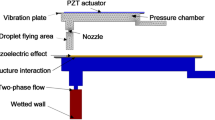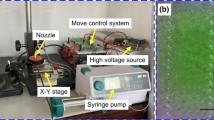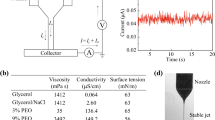Abstract
Electrohydrodynamic (EHD) printing is a very promising approach for micro/nanoscopic additive manufacturing but suffers from printing stability problems due to the insufficient knowledge of its controlling techniques. Here, we conduct a numerical study on EHD printing under six unconventional pulsed voltage waveforms and investigate the influences of upward/downward voltage time and waveform shape on liquid behaviors and printing outcomes. With the assistance of the clear snapshots, voltage distribution, and interface charge density obtained from the numerical results, it is discovered that the three upward voltage waveforms only alter the duration of Taylor cone formation with very minor impact on the printing process and deposited droplet volume. On the other hand, all three downward voltage waveforms exert a significant influence on liquid behaviors. The printing processes under the trapezoidal down waveform are the most stable ones owing to the continuous and smooth voltage reduction. The processes under the two steps down waveform are similar to the trapezoidal down waveform but become unstable when the downward time is too long. Due to the two drastic voltage drops, the processes under the one step down waveform are the least stable and produce more satellite droplets than the other two waveforms. The volume of deposited droplet generally decreases with increasing downward time for all three waveforms, and the droplets produced under the one step down waveform are smaller than the other two waveforms, resulting from the rapidly reduced electric force after the voltage switches. To our best knowledge, this is the first numerical work on EHD printing under various unconventional waveforms. The results obtained in this paper provide useful addition to the understanding of its complicated mechanisms.

















Similar content being viewed by others
Data availability
The data that support the findings of this study are available within the article.
Abbreviations
- \(\overrightarrow{U}\) :
-
Liquid velocity
- \(\rho\) :
-
Liquid density
- \(\mu\) :
-
Liquid dynamic viscosity
- \(\gamma\) :
-
Liquid surface tension coefficient
- \(\varepsilon\) :
-
Liquid permittivity
- \(K\) :
-
Liquid electrical conductivity
- \(\overrightarrow{{F}_{\gamma }}\) :
-
Surface tension force
- \(\kappa\) :
-
Mean curvature of liquid–gas interface
- \(\widehat{n}\) :
-
Unit normal of gas–liquid interface
- \(F\) :
-
VOF function
- \(\Phi\) :
-
Electric voltage
- \(\overrightarrow{E}\) :
-
Electric field
- \(\overrightarrow{{F}_{e}}\) :
-
Electrostatic force
- \({\rho }_{e}\) :
-
Liquid–gas interface charge density
- \({t}_{u}\) :
-
Upward voltage time
- \({t}_{d}\) :
-
Downward voltage time
- \({t}_{f}\) :
-
Taylor cone formation time
- \({t}_{j}\) :
-
Jetting time
- \({t}_{o}\) :
-
Meniscus oscillation time
- \({t}_{deta}\) :
-
Jet detachment time
- \({V}_{d}\) :
-
Deposited droplet volume
References
Altintas Y, Torun I, Yazici AF, Beskazak E, Erdem T, Onses MS, Mutlugun E (2020) Multiplexed patterning of cesium lead halide perovskite nanocrystals by additive jet printing for efficient white light generation. Chem Eng J 380:122493
An S, Lee MW, Kim NY, Lee C (2014) Effect of viscosity, electrical conductivity, and surface tension on direct-current-pulsed drop-on-demand electrohydrodynamic printing frequency. Appl Phys Lett 105:214102
An BW, Kim K, Lee H, Kim SY, Shim Y, Lee DY, Song JY, Park JU (2015) High-resolution printing of 3D structures using an electrohydrodynamic inkjet with multiple functional inks. Adv Mater 27:4322–4328
Bober DB, Chen CH (2011) Pulsating electrohydrodynamic cone-jets: from choked jet to oscillating cone. J Fluid Mech 689:552–563
Brackbill JU, Kothe DB, Zemach C (1992) A continuum method for modeling surface tension. J Comput Phys 100:335–354
Cai S, Sun Y, Wang Z, Yang W, Li X, Yu H (2021) Mechanisms, influencing factors, and applications of electrohydrodynamic jet printing. Nanotechnol Rev 10:1046–1078
Chen M, Lee H, Yang J, Xu Z, Kim JT (2020) Parallel, multi-material electrohydrodynamic 3D nanoprinting. Small 16:1906402
Choi HK, Park JU, Park OO, Ferreira PM, Georgiadis JG, Rogers JA (2008) Scaling laws for jet pulsations associated with high-resolution electrohydrodynamic printing. Appl Phys Lett 92:123109
Collins RT, Sambath K, Harris MT, Basaran OA (2013) Universal scaling laws for the disintegration of electrified drops. Proc Natl Acad Sci 110:4905–4910
Dastourani H, Jahannama MR, Eslami-Majd A (2018) A physical insight into electrospray process in cone-jet mode: role of operating parameters. Int J Heat Fluid Fl 70:315–335
Dastourani H, Jahannama MR, Eslami-Majd A (2021) Effects of surrounding pressure on cone–jet formation in electrospray process. Microfluid Nanofluid 25:1–15
Deng W, Gomez A (2012) Full transient response of Taylor cones to a step change in electric field. Microfluid Nanofluid 12:383–393
Deshpande SS, Anumolu L, Trujillo MF (2012) Evaluating the performance of the two-phase flow solver interFoam. Comput Sci Discovery 5:014016
Ferziger JH, Peric M, Street RL (2002) Computational methods for fluid dynamics. Springer, Berlin
Ganán-Calvo AM, López-Herrera JM, Herrada MA, Ramos A, Montanero JM (2018) Review on the physics of electrospray: from electrokinetics to the operating conditions of single and coaxial Taylor cone-jets, and AC electrospray. J Aerosol Sci 125:32–56
Guan Y, Wu S, Wang M, Tian Y, Lai W, Huang Y (2022a) Numerical analysis of electrohydrodynamic jet printing under constant and step change of electric voltages. Phys Fluids 34:062005
Guan Y, Wu S, Wang M, Tian Y, Yu C, Lai W, Huang Y (2022b) Numerical investigation of high-frequency pulsating electrohydrodynamic jet at low electric Bond numbers. Phys Fluids 34:012001
Guo L, Duan Y, Huang YA, Yin Z (2018) Experimental study of the influence of ink properties and process parameters on ejection volume in electrohydrodynamic jet printing. Micromachines 9:522
Hijano AJ, Loscertales IG, Ibáñez SE, Higuera FJ (2015) Periodic emission of droplets from an oscillating electrified meniscus of a low-viscosity, highly conductive liquid. Phys Rev E 91:013011
Hirt CW, Nichols BD (1981) Volume of fluid (VOF) method for the dynamics of free boundaries. J Comput Phys 39:201–225
Jiang Z, Gan Y, Shi Y (2020) An improved model for prediction of the cone-jet formation in electrospray with the effect of space charge. J Aerosol Sci 139:105463
Kwon KS, Lee DY (2013) Investigation of pulse voltage shape effects on electrohydrodynamic jets using a vision measurement technique. J Micromech Microeng 23:065018
Kwon HJ, Hong J, Nam SY, Choi HH, Li X, Jeong YJ, Kim SH (2021) Overview of recent progress in electrohydrodynamic jet printing in practical printed electronics: focus on variety of printable materials for each component. Mater Adv. 2(17):5593–5615
Lee MW, An S, Kim NY, Seo JH, Huh JY, Kim HY, Yoon SS (2013) Effects of pulsing frequency on characteristics of electrohydrodynamic inkjet using micro-Al and nano-Ag particles. Exp Therm Fluid Sci 46:103–110
Li H, Yang W, Duan Y, Nie Q, Shao Z, Yin Z, Huang Y (2021) Enhancing pulsed electrohydrodynamic printing frequency via high-order-mode ejection. Phys Fluids 33:081704
Li H, Yang W, Duan Y, Chen W, Zhang G, Huang Y, Yin Z (2022) Residual oscillation suppression via waveform optimization for stable electrohydrodynamic drop-on-demand printing. Addit Manuf 55:102849
Melcher JR, Taylor GI (1969) Electrohydrodynamics: a review of the role of interfacial shear stresses. Annu Rev Fluid Mech 1:111–146
Mishra S, Barton KL, Alleyne AG, Ferreira PM, Rogers JA (2010) High-speed and drop-on-demand printing with a pulsed electrohydrodynamic jet. J Micromech Microeng 20:095026
Mohammadi K, Movahhedy MR, Khodaygan S (2019) A multiphysics model for analysis of droplet formation in the electrohydrodynamic 3D printing process. J Aerosol Sci 135:72–85
Onses MS, Sutanto E, Ferreira PM, Alleyne AG, Rogers JA (2015) Mechanisms, capabilities, and applications of high-resolution electrohydrodynamic jet printing. Small 11:4237–4266
Park JW, Kang BH, Kim HJ (2020) A review of low-temperature solution-processed metal oxide thin-film transistors for flexible electronics. Adv Funct Mater 30:1904632
Phung TH, Kim S, Kwon KS (2017) A high speed electrohydrodynamic (EHD) jet printing method for line printing. J Micromech Microeng 27:095003
Pilliod JE Jr, Puckett EG (2004) Second-order accurate volume-of-fluid algorithms for tracking material interfaces. J Comput Phys 199:465–502
Rosell-Llompart J, Grifoll J, Loscertales IG (2018) Electrosprays in the cone-jet mode: from Taylor cone formation to spray development. J Aerosol Sci 125:2–31
Saville D (1997) A. Electrohydrodynamics: the taylor-Melcher leaky dielectric model. Annu Rev Fluid Mech 29:27–64
Scardovelli R, Zaleski S (1999) Direct numerical simulation of free-surface and interfacial flow. Annu Rev Fluid Mech 31:567–603
Stachewicz U, Yurteri CU, Marijnissen JCM, Dijksman JF (2009) Stability regime of pulse frequency for single event electrospraying. Appl Phys Lett 95:224105
Stachewicz U, Yurteri CU, Dijksman JF, Marijnissen JCM (2010) Single event electrospraying of water. J Aerosol Sci 41:963–973
Wang Q, Zhang G, Zhang H, Duan Y, Yin Z, Huang Y (2021) High-resolution, flexible, and full-color perovskite image photodetector via electrohydrodynamic printing of ionic-liquid-based ink. Adv Funct Mater 31:2100857
Wei C, Qin H, Ramírez-Iglesias NA, Chiu CP, Lee YS, Dong J (2014) High-resolution ac-pulse modulated electrohydrodynamic jet printing on highly insulating substrates. J Micromech Microeng 24:045010
Wu Y (2021) Electrohydrodynamic jet 3D printing in biomedical applications. Acta Biomater 128:21–41
Yang J, Cho B, Chung J (2018) Optimization of pulsed voltage waveform for electrohydrodynamic jetting on-demand. J Mech Sci Technol 32:3775–3786
Yuan X, **ong Z (2018) High frequency pulsed electrohydrodynamic printing with controllable fine droplets. J Micromech Microeng 28:095008
Yuan X, Ba Z, **ong Z (2015) Fine droplet generation using tunable electrohydrodynamic pulsation. J Micromech Microeng 25:075028
Zhang B, He J, Li X, Xu F, Li D (2016) Micro/nanoscale electrohydrodynamic printing: from 2D to 3D. Nanoscale 8:15376–15388
Acknowledgements
This work was supported by the National Key R&D Program of China (2021YFB3200701), and the National Natural Science Foundation of China (Nos. 51906073 and 52188102). The authors would also like to thank the Flexible Electronics Manufacturing Laboratory at the Comprehensive Experiment Center for access to advanced manufacturing and equipment technology. The computation is completed in the HPC Platform of Huazhong University of Science and Technology.
Funding
This work was supported by the National Key R&D Program of China (Grant number 2021YFB3200701), and the National Natural Science Foundation of China (Grant numbers 51906073 and 52188102).
Author information
Authors and Affiliations
Contributions
Conceptualization: YG; methodology: YG, MW; formal analysis and investigation: YG, MW, SW, YT; writing—original draft preparation: YG, DY; writing—review and editing: DY, YAH; funding acquisition: YG, YAH; supervision: YAH.
Corresponding authors
Ethics declarations
Conflict of interest
The authors declare that they have no conflict of interest.
Additional information
Publisher's Note
Springer Nature remains neutral with regard to jurisdictional claims in published maps and institutional affiliations.
Rights and permissions
Springer Nature or its licensor (e.g. a society or other partner) holds exclusive rights to this article under a publishing agreement with the author(s) or other rightsholder(s); author self-archiving of the accepted manuscript version of this article is solely governed by the terms of such publishing agreement and applicable law.
About this article
Cite this article
Guan, Y., Wang, M., Wu, S. et al. Modeling and analysis of electrohydrodynamic printing under various pulsed voltage waveforms. Microfluid Nanofluid 27, 10 (2023). https://doi.org/10.1007/s10404-022-02621-4
Received:
Accepted:
Published:
DOI: https://doi.org/10.1007/s10404-022-02621-4




